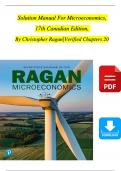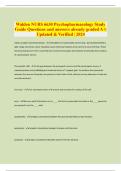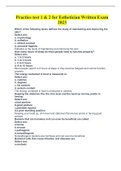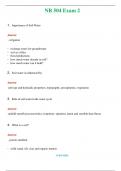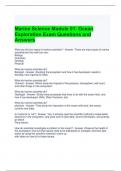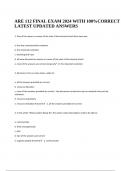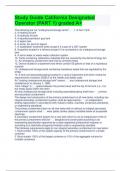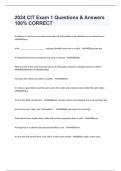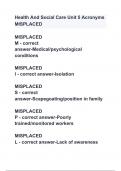Solution Manual For Microeconomics,
17th Canadian Edition,
By Christopher Ragan |Verified Chapters 20
,Contents
Part One: What Is Economics? 1
Chapter 1: Economic Issues and Concepts 3
Chapter 2: Economic Theories, Data, and Graphs 13
Part Two: An Introduction to Demand and Supply 26
Chapter 3: Demand, Supply, and Price 27
Chapter 4: Elasticity 40
Chapter 5: Price Controls and Market Efficiency 54
Part Three: Consumers and Producers 65
Chapter 6: Consumer Behaviour 66
Chapter 7: Producers in the Short Run 81
Chapter 8: Producers in the Long Run 95
Part Four: Market Structure and Efficiency 104
Chapter 9: Competitive Markets 105
Chapter 10: Monopoly, Cartels, and Price Discrimination 116
Chapter 11: Imperfect Competition and Strategic Behaviour 131
Chapter 12: Economic Efficiency and Public Policy 140
Part Five: Factor Markets 150
Chapter 13: How Factor Markets Work 152
Chapter 14: Labour Markets and Income Inequality 163
Chapter 15: Interest Rates and the Capital Market 175
Part Six: Government in the Market Economy 183
Chapter 16: Market Failures and Government Intervention 185
Chapter 17: The Economics of Environmental Protection 198
Chapter 18: Taxation and Public Expenditure 210
Part Seven: Canada in the Global Economy 219
Chapter 19: The Gains from International Trade 220
Chapter 20: Trade Policy 229
, Chapter 1: Economic Issues and Concepts iii
List of Boxes
Applying Economic Concepts
1-1 The High Opportunity Cost of Your University Degree 7
1-2 Economics Needs the Other Social Sciences 21
2-1 Where Economists Work 30
2-2 Can Economists Design Controlled Experiments to Test Their Theories? 34
3-1 Demand and Supply Shocks Created by the COVID-19 Pandemic 64
3-2 Why Apples but Not iPhones? 72
4-1 Who Really ―Pays‖ for Payroll Taxes? 93
5-1 Minimum Wages and Unemployment 105
5-2 The Debate Over ―Price Gouging‖: Efficiency Versus Public Virtue 118
6-1 Rationality and Framing in Consumer Behaviour 130
7-1 Is It Socially Responsible to Maximize Profits? 160
7-2 Three Examples of Diminishing Returns 168
7-3 The Digital World: When Diminishing Returns Disappear Altogether 174
8-1 The Significance of Productivity Growth 191
9-1 Why Small Firms Are Price Takers 207
9-2 The Parable of the Seaside Inn 217
10-1 Network Effects as Entry Barriers 239
12-1 Potential Mergers in the Canadian Airline Industry 302
14-1 The Rise of the ―Gig‖ Economy 356
15-1 Inflation and Interest Rates 380
16-1 The World‘s Endangered Fish 398
16-2 Used Cars and the Market for ―Lemons‖ 404
18-1 Using a UBI to Eliminate Poverty 466
19-1 Two Examples of Absolute and Comparative Advantage 484
19-2 Comparative Advantage and Global Supply Chains 492
20-1 Canadian Wine: A Free-Trade Success Story 520
Lessons from History
4-1 Economic Development and Income Elasticities 95
8-1 Jacob Viner and the Clever Draftsman 189
9-1 What Do Whaling Ships and Oil Wells Have in Common? 224
10-1 Disruptive Technologies and Creative Destruction 241
12-1 Are Amazon and Facebook the Standard Oil of the Twenty-First Century? 300
13-1 David Ricardo and ―Economic Rent‖ 327
20-1 Tariff Wars and the Stark Lessons from the Great Depression 508
,iv Instructor‘s Solutions Manual for Ragan, Microeconomics, Seventeenth Canadian Edition
Extensions in Theory
3-1 The Distinction Between Stocks and Flows 53
11-1 The Prisoners‘ Dilemma 270
16-1 Arthur Okun‘s ―Leaky Bucket‖ 406
18-1 Who Really Pays the Corporate Income Tax? 450
19-1 The Gains from Trade More Generally 482
Part One
What Is Economics?
This opening Part of the book provides an introduction to economics. The central themes of
Chapter 1 are scarcity, choice, opportunity cost, and the self-organizing role of markets. The
chapter also examines the gains from specialization and trade, the role of money, the effects of
globalization, and ends with a discussion of the various types of economic systems. Chapter 2
examines how economists build their models and test their theories. It also addresses central
methodological issues, the most important being the idea that the progress of economics (like all
scientific disciplines) depends on relating our theories to what we observe in the world around us.
Finally, the chapter has an extensive section on graphing.
***
Chapter 1 opens with a brief tour of some key economic issues in Canada and other countries—
from rising protectionism and the dangers of climate change to accelerating technological change
and growing income inequality. The purpose is to whet the reader‘s appetite for the kinds of issues
economists are thinking about today. This offers a natural segue to the discussion of scarcity,
without which few of these issues would be very interesting. The chapter addresses the
fundamental concepts of scarcity, choice, and opportunity cost, illustrating these ideas with a
production possibilities boundary. (It is worth noting that these concepts are relevant to all
economies, whether they are organized by central planning or by free markets.) We then examine
the complexity of modern market economies, examining the decision makers, production, trade,
money, and globalization. Finally, we examine different types of economic systems, including
traditional, command, and free-market systems. We emphasize that all actual economies are
mixtures, containing elements of all three pure systems.
Chapter 2 provides a longer introduction to the methodological issues of economics than is
usually included in introductory texts. We do this because most students believe that the scientific method
is limited to the natural sciences. But to fully appreciate economics, they must understand that its theories
are also open to empirical testing and that these theories continually change as a result of what the
, Chapter 1: Economic Issues and Concepts v
empirical evidence shows. We understand that some instructors feel their time is so limited that they
cannot spend class time on Chapter 2. We believe that even if it is not covered in class, students‘ attention
should be called to the issues addressed in the chapter. Our experience is that students benefit from some
discussion of the scientific method and from the insight that the social sciences are not all that different
from the ―hard‖ sciences, at least in their basic approaches.
,vi Instructor‘s Solutions Manual for Ragan, Microeconomics, Seventeenth Canadian Edition
The chapter begins by making the distinction between positive and normative statements. We then work
carefully through the various elements of economic theories, including definitions, assumptions, and
predictions. Testing theories is as important as developing them, so we emphasize the interaction between
theorizing and empirical observation. We then present various types of economic data, and this gets us
into a detailed discussion of index numbers, time-series and cross-section data, and graphs. The final
section of the chapter goes through graphing in detail.
,Chapter 1: Economic Issues and Concepts vii
, Chapter 1: Economic Issues and Concepts
This chapter is in three main sections, which begins after a brief introductory mention of some key
economic issues of the day. The first substantive section develops the concepts of scarcity, choice, and
opportunity cost. To ensure the student really understands what opportunity cost is all about, we have a
box that examines the opportunity cost of a university or college degree. This should be a familiar
example to which students can easily relate. The production possibilities boundary is then introduced, and
it is shown to embody the three key concepts of scarcity, choice and opportunity cost. Its nature as a
frontier between attainable and unattainable is worth stressing, as is the fact that what is attainable is itself
subject to change. Four key economic problems are then discussed, and each one is expressed in terms of
the production possibilities boundary. These questions give the student an inkling of the types of
questions addressed both in microeconomics and in macroeconomics.
The chapter‘s second section examines the complexity of modern economies, asking why the
things we want to purchase are almost always available. What produces this remarkable coordination? We
discuss the market as an instrument that brings order to the economy as a whole. Along the way, the
student is introduced to Adam Smith‘s ―invisible hand‖. The section also discusses who makes the many
millions of choices in a market economy, and why incentives matter to the decision-makers. We show the
circular flow of income and expenditure as a way of showing the interaction between consumers and
producers. We also examine the nature of maximizing decisions (both utility and profit), and the
importance of decisions at the margin. Finally, on the production side, we examine the role of
specialization, the division of labour, globalization, and the importance of money in facilitating trade.
The chapter‘s third and final section deals with comparative economic systems. Students will read
in almost every chapter of this book about a market economy. Contrasting it with planned and traditional
economies is a good way to gain some insight into the concept at the outset. We emphasize that actual
economies are rarely, if ever, well represented by the extremes; instead, actual economies are mixed
economies, with varying degrees of government ownership and planning. Students are introduced to Karl
Marx‘s argument for a centrally planned economy. While Marx had many things right, we argue that
central planning has not been successful in proving itself as an efficient way of organizing an economy,
allocating resources, or generating prosperity for a large fraction of the population. We have added a new
box to this chapter explaining why a thorough understanding of economic phenomena and economic
policy requires drawing insights from the other social sciences.
, Chapter 3: Demand, Supply, and Price ix
Answers to Study Exercises
Fill-in-the-Blank Questions
Question 1
a) land, labour, capital; factors
b) opportunity cost
c) production possibilities boundary
d) scarcity (because points outside the boundary are unattainable); downward (or negative); the
opportunity cost associated with any choice
e) constant; increasing
f) increases (meaning that more units of good B must be given up to get an extra unit of good A)
Question 2
a) self; self-interest
b) incentives
c) firms; households; governments
d) increase (maximize); increase (maximize)
e) margin; (marginal) cost
Question 3
a) division; specialization
b) trade
c) money
d) globalization
, x Instructor‘s Solutions Manual for Ragan, Microeconomics, Seventeenth Canadian Edition
Review Questions
Question 4
Any realistic production possibilities boundary displays scarcity, the need for choice, and
opportunity cost.
Scarcity: The production possibilities boundary (PPB) separates attainable combinations of
goods from those that are unattainable. Thus scarcity is shown by the existence of some
unattainable bundles of goods.
Choice: Because of scarcity, societies must somehow choose how resources are to be allocated;
thus a particular point on the PPB must be chosen.
Opportunity Cost: The slope of the PPB is negative, revealing the opportunity cost that is
unavoidable every time a choice is made. For the economy as a whole, the decision to produce
more of one good must involve a decision to produce less of some other good.
Question 5
Consider any country‘s production possibilities boundary, and suppose the two products are X
and Y. A technological improvement in industry X shifts the PPB out (along the X axis),
increasing the maximum amount of X that can be produced. Note that the maximum amount of
Y that can be produced has not changed. But since the PPB has shifted out, there are many
combinations of both goods that are now available that were not before, and some of these
involve producing more of both goods. Thus, even though the technology for producing Y has
not changed, the technological improvement in X does allow the country to choose to produce
more of both products.
Question 6
The central ideas illustrated by the two-good version of the production possibilities boundary (PPB) are
scarcity, choice, and opportunity cost. Exactly the same ideas can be illustrated in a more realistic three-
good version of the model, which is more complicated to draw, or by the much more realistic N-good
version of the model (with N 4), which is impossible to draw. Thus the assumption of only two goods is
merely a simplifying one: it allows us to easily grasp and illustrate some central points that would be
more difficult to understand in the more general N-good case.
Question 7
a) If all Canadian families had $80,000 of after-tax income (roughly the Canadian average), it would be
difficult to say that real poverty existed in Canada. At this level of income, all families would easily have
enough income to provide the essentials of food, shelter, and clothing, and could also have much beyond
these essentials. However, there would still be many things that these families could not afford, such as
expensive university education, expensive vacations, a cottage in the country, etc. Defining poverty with
any precision is difficult, and we will say more about this in Chapter 18.

